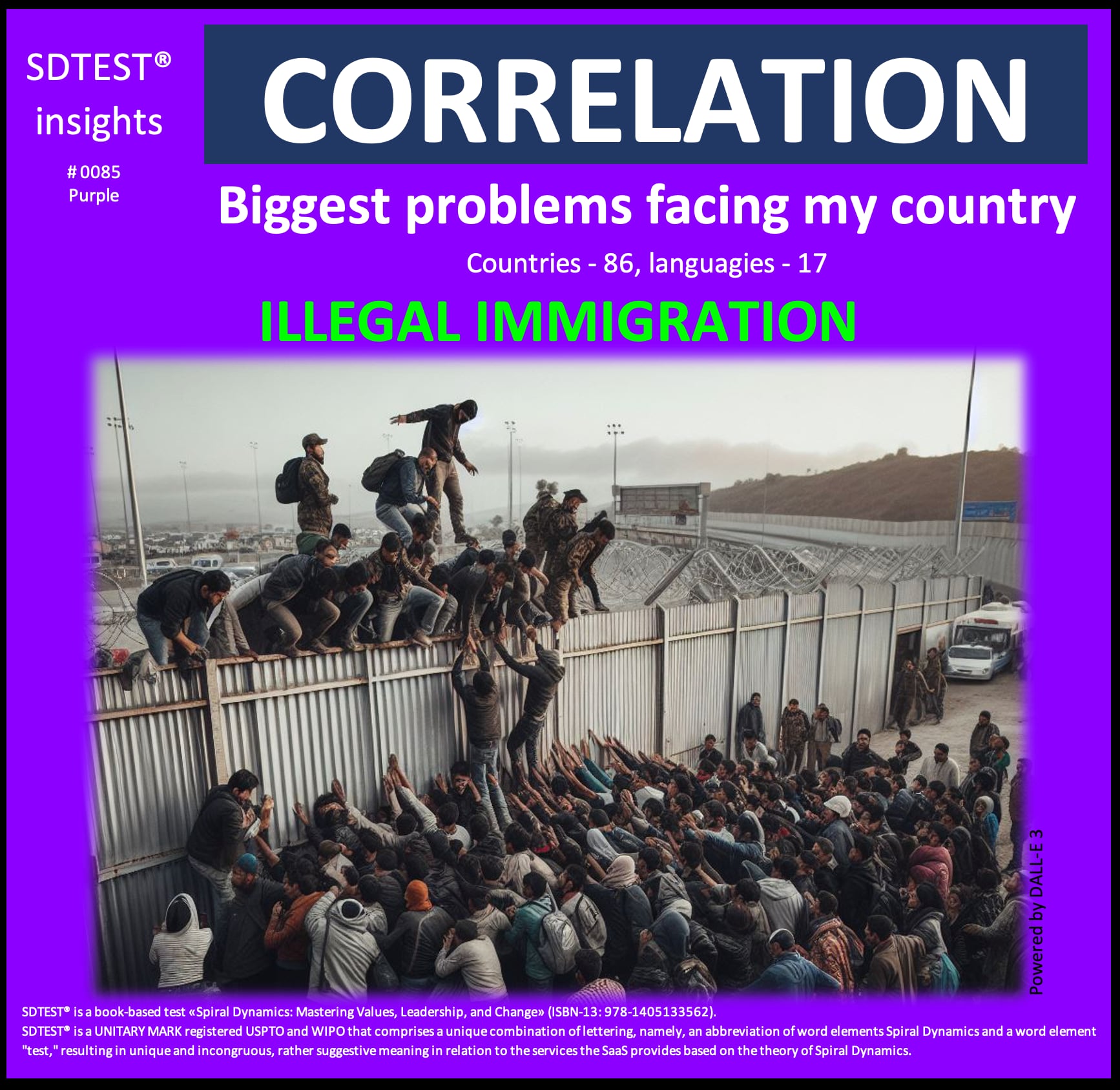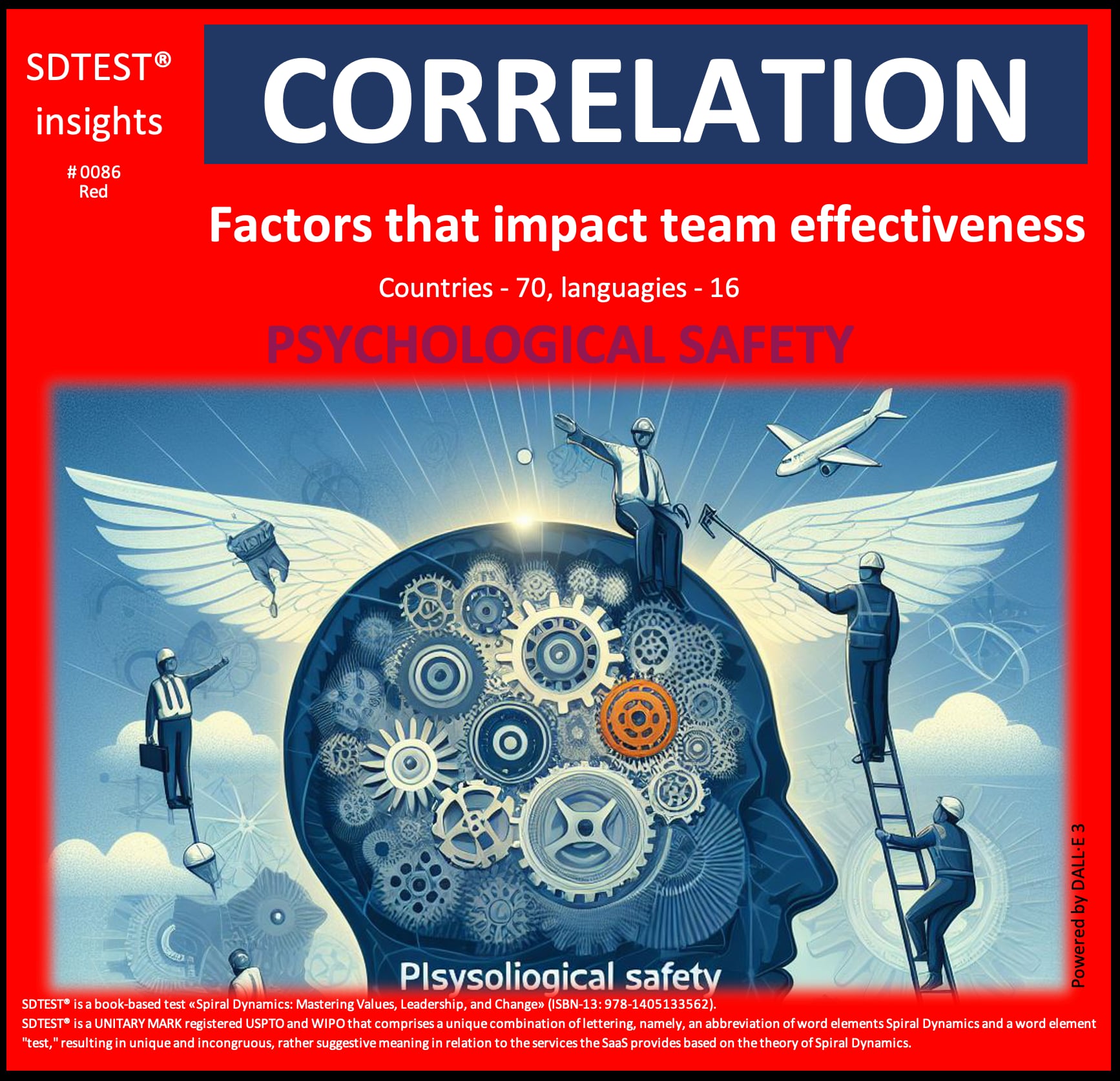Mastering Values, Leadership, and
Change» (ISBN-13: 978-1405133562)

SDTEST® has 28 different VUCA polls that calculate the 9,191 correlation values between stages of development according to the theory of Spiral Dynamics and answer options of these 28 polls.
We invite curiosity about the systemic mechanisms behind this correlation. There may be hidden variables that provide alternative explanations.
0.0881 between the Illegal immigration and the Purple stage.
The critical value of the correlation coefficient for a normal distribution, by William Sealy Gosset (Student) r = 0.0525. This positive correlation of 0.0881 meets the reliability criteria but does not necessarily imply causation.

This positive correlation of 0.0881 exceeds the critical value of 0.0525 and meets the reliability criteria for further examination. The Purple value system emphasizes tradition, spirituality, and a deep sense of belonging to a group or community.
In the context of this correlation, the perception of "Illegal immigration" as a significant problem could resonate with Purple vMeme's emphasis on preserving traditional ways of life, maintaining a cohesive sense of community, and protecting one's group's established norms and practices.
Individuals at the Purple stage may view illegal immigration as a potential threat to the cultural and social fabric of their community, as well as a challenge to the established order and traditions that have been passed down through generations.
Additionally, the Purple value system's reliance on rituals, taboos, and strict adherence to group norms could contribute to a perception that illegal immigration represents a deviation from the accepted rules and boundaries that define the in-group and out-group dynamics.
-0.0939 between the Psychological safety and the Red stage.
The critical value of the correlation coefficient for a normal distribution, by William Sealy Gosset (Student) r = 0.0607. This negative correlation of -0.0939 meets the reliability criteria but does not necessarily imply causation.

This negative correlation of -0.0939 exceeds the critical value of 0.0607, meets the reliability criteria for further examination, and could be explained by the Red vMeme's tendencies towards assertiveness, self-interest, and a disregard for interpersonal considerations that may be perceived as hindering personal goals or desires.
The Red value system is characterized by a strong focus on power, self-expression, individualism, and a desire for immediate gratification. Individuals operating primarily from this worldview tend to be driven by their impulses, desires, and a sense of dominance. They are often competitive, assertive, and willing to use force or coercive means to achieve their goals, with little concern for established rules or laws.
Individuals at the Red stage may prioritize more overtly competitive or dominance-oriented dynamics within teams, potentially viewing the concept of "Psychological safety" as a hindrance to their ability to express themselves freely or assert their influence.
The Red value system's impulsiveness and focus on immediate gratification could contribute to a mindset that places less importance on creating a psychologically safe environment, as it may be perceived as a less direct path to achieving personal objectives or satisfying immediate desires.
-0.0589 between the Empathetic and the Blue stage.
The critical value of the correlation coefficient for a normal distribution, by William Sealy Gosset (Student) r = 0.0432. This negative correlation of -0.0589 meets the reliability criteria but does not necessarily imply causation.

This negative correlation of -0.0589 exceeds the critical value of 0.0432, meets the reliability criteria for further analysis, and could be explained by Blue vMeme's focus on adherence to established rules, hierarchies, and codes of conduct.
The Blue value system strongly emphasizes order, rules, duty, discipline, and adherence to a moral code handed down from a higher authority. Individuals operating from this worldview tend to be conformists and rule-bound, with a strong sense of loyalty and responsibility towards their group or organization.
Individuals at the Blue stage may prioritize qualities in leaders that reinforce order, discipline, and adherence to established norms and procedures rather than prioritizing empathy or considering the subjective experiences and emotional states of others.
The Blue value system's strong sense of duty and responsibility towards one's organization or role could contribute to a perception that empathy should not supersede adherence to established protocols or directives from higher authorities.
-0.0691 between the Empathy and the Orange stage.
The critical value of the correlation coefficient for a normal distribution, by William Sealy Gosset (Student) r = 0.0428. This negative correlation of -0.0691 meets the reliability criteria but does not necessarily imply causation.

This negative correlation of -0.0691 exceeds the critical value of 0.0428, meets the reliability criteria for further examination, and could be explained by the Orange vMeme's focus on objective, analytical thinking and a potential tendency to prioritize task-oriented or outcome-driven approaches over interpersonal considerations.
The Orange value system strongly emphasizes reason, science, technology, and achieving goals through rational, logical thinking and applying scientific methods. Individuals operating primarily from this worldview tend to be ambitious, goal-oriented, individualistic, and competitive, valuing independence, progress, efficiency, and results.
Individuals at the Orange stage may be more inclined to view success through the lens of measurable results, efficiency, and the application of logical reasoning or scientific methods rather than prioritizing the subjective experiences or emotional states of others.
Additionally, the Orange value system's emphasis on individualism, self-reliance, and competitiveness could contribute to a mindset that places less importance on empathy, as it may be perceived as a less direct path to achieving personal goals or objectives in the workplace.
0.0776 between the Yes, I am ready to receive 10% less pay to work remotely, and the Green stage.
The critical value of the correlation coefficient for a normal distribution, by William Sealy Gosset (Student) r = 0.0665. This positive correlation of 0.0776 meets the reliability criteria but does not necessarily imply causation.

This positive correlation of 0.0776 exceeds the critical value of 0.0665, meets the reliability criteria for further examination, and could be explained by the the Green vMeme's emphasis on work-life balance, environmental sustainability, and a desire to prioritize quality of life over purely financial considerations.
The Green value system represents a holistic, community-oriented worldview focused on unity, cooperation, ecological harmony, and well-being. This stage values systems thinking, sustainability, and an egalitarian approach to decision-making.
Individuals operating from the Green value system may be more inclined to appreciate the potential benefits of remote work, such as reduced commuting time, a lower environmental impact, and increased flexibility to balance professional and personal responsibilities.
The Green vMeme's focus on community and cooperation could contribute to the perception that accepting a pay cut in exchange for remote work is a reasonable trade-off. This may foster a more harmonious work-life dynamic and benefit both the individual and the broader social or ecological context.
-0.0721 between the Trustworthiness and the Yellow stage.
The critical value of the correlation coefficient for a normal distribution, by William Sealy Gosset (Student) r = 0.0455. This negative correlation of -0.0721 meets the reliability criteria but does not necessarily imply causation.

This negative correlation of -0.0721 exceeds the critical value of 0.0455 and meets the reliability criteria for further examination. One potential explanation could be that individuals at the Yellow vMeme may recognize the importance of situational factors, contextual complexities, and the need for adaptability in leadership styles rather than relying solely on a singular trait like trustworthiness.
The Yellow value system represents the ability to integrate and transcend the previous value systems, characterized by a holistic, systems-thinking approach, an understanding of complex systems, and a focus on personal growth and development. Individuals operating from this stage are known for their ability to see multiple perspectives and their integrative approach to understanding the world.
Additionally, the Yellow value system's emphasis on personal growth and development could contribute to a perception that effective leadership requires a continuous learning process, self-awareness, and the ability to evolve and adapt to changing circumstances, which may not be fully captured by the concept of trustworthiness alone.
-0.0926 between the Age group 25-29 years and the Turquoise stage.
The critical value of the correlation coefficient for a normal distribution, by William Sealy Gosset (Student) r = 0.0833. This negative correlation of -0.0926 meets the reliability criteria but does not necessarily imply causation.

This negative correlation of -0.0926 exceeds the critical value of 0.0833; it meets the reliability criteria for further examination and could be explained by the following factors:
The Turquoise value system represents a holistic, integrated, and ecological perspective characterized by a recognition of the interconnectedness of all things, a focus on sustainability, and a concern for the well-being of people and the planet. Individuals operating from this stage tend to be driven by compassion, empathy, and a desire for inclusiveness.
What insights do you gain from today's correlation? How might we study this relationship more carefully before deducing causation?
We welcome respectful and wise perspectives! Stay tuned every week as we share more results and insights.
After login or registration, free access to the poll results in the FAQ section.
